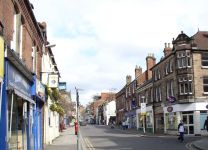Belper is a town and civil parish in the local government district of Amber Valley in Derbyshire, England, located about 7 miles (11 km) north of Derby on the River Derwent. As well as Belper itself, the parish also includes the village of Milford and the hamlets of Bargate, Blackbrook and Makeney. As of the 2011 Census, the parish had a population of 21,823. Originally a centre for the nail-making industry since Medieval times, Belper expanded during the early Industrial Revolution to become one of the first mill towns with the establishment of several textile mills; as such, it forms part of the Derwent Valley Mills World Heritage Site.
History
At the time of the Norman occupation, Belper was part of the land centred on Duffield held by the family of Henry de Ferrers. The Domesday Survey records a manor of "Bradley" which is thought to have stood in an area of town now known as the Coppice. At that time it was probably within the Forest of East Derbyshire which covered the whole of the county east of the Derwent. It was possibly appropriated by William de Ferrers, 4th Earl of Derby at some time after it was disafforested in 1225 and became part of Duffield Frith.
The town's name is thought to be a corruption of Beaurepaire – meaning beautiful retreat – the name given to a hunting lodge, the first record of which being in a charter of 1231. This would have been the property of Edmund Crouchback, 1st Earl of Lancaster who died in 1296, the record of his estate mentioning "a capital mansion". The chapel built at that time still exists. Originally consecrated in 1250 as the Chapel of St Thomas, it was rededicated to St John during the reign of King Henry VIII. St John's Chapel is still in use today and is thought to be the oldest building still standing in Belper.
The coal deposits of Derbyshire are frequently associated with ironstone within the clay substrate. Initially obtained from surface workings, it would later have been mined in shallow bell pits. It is thought that this w
